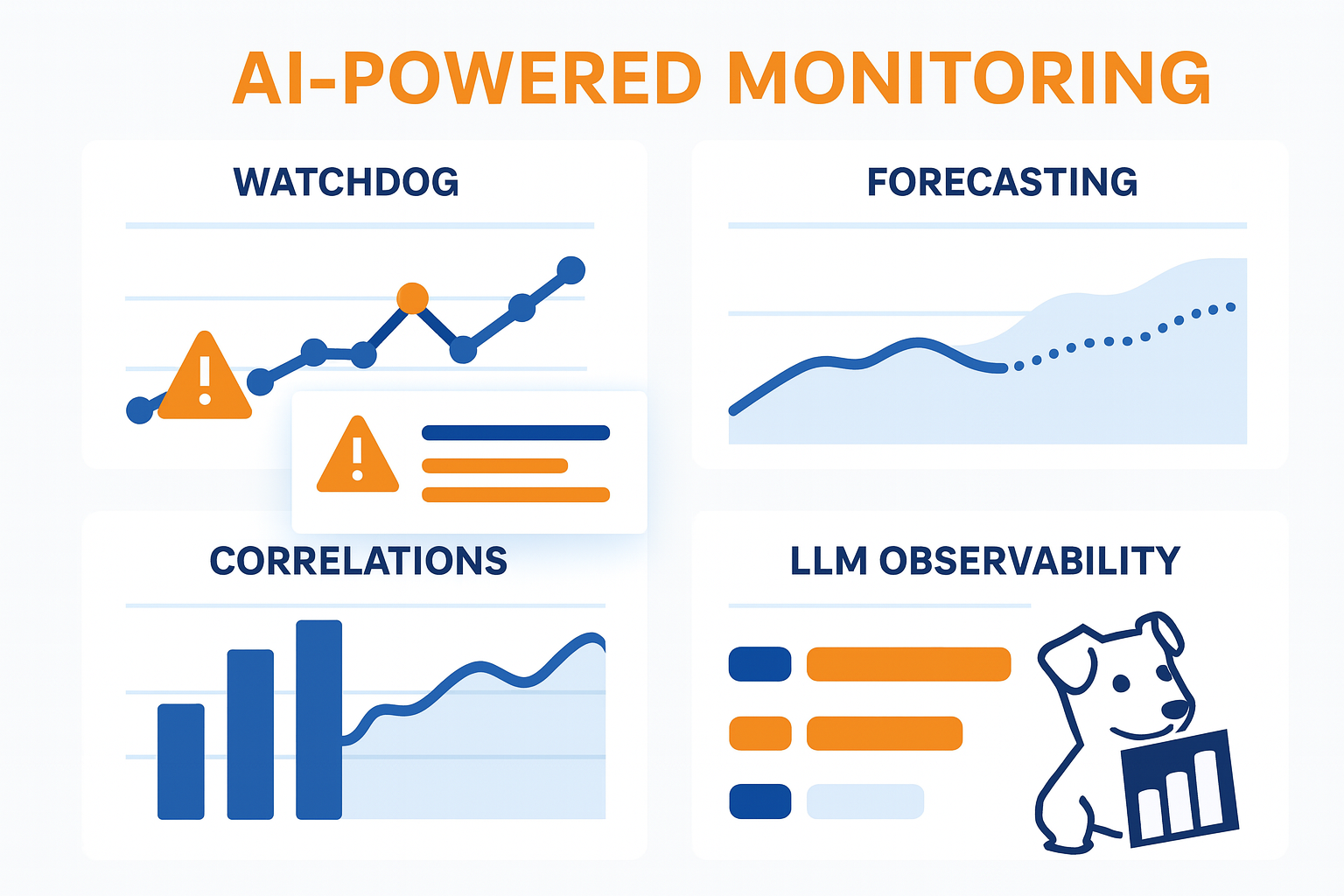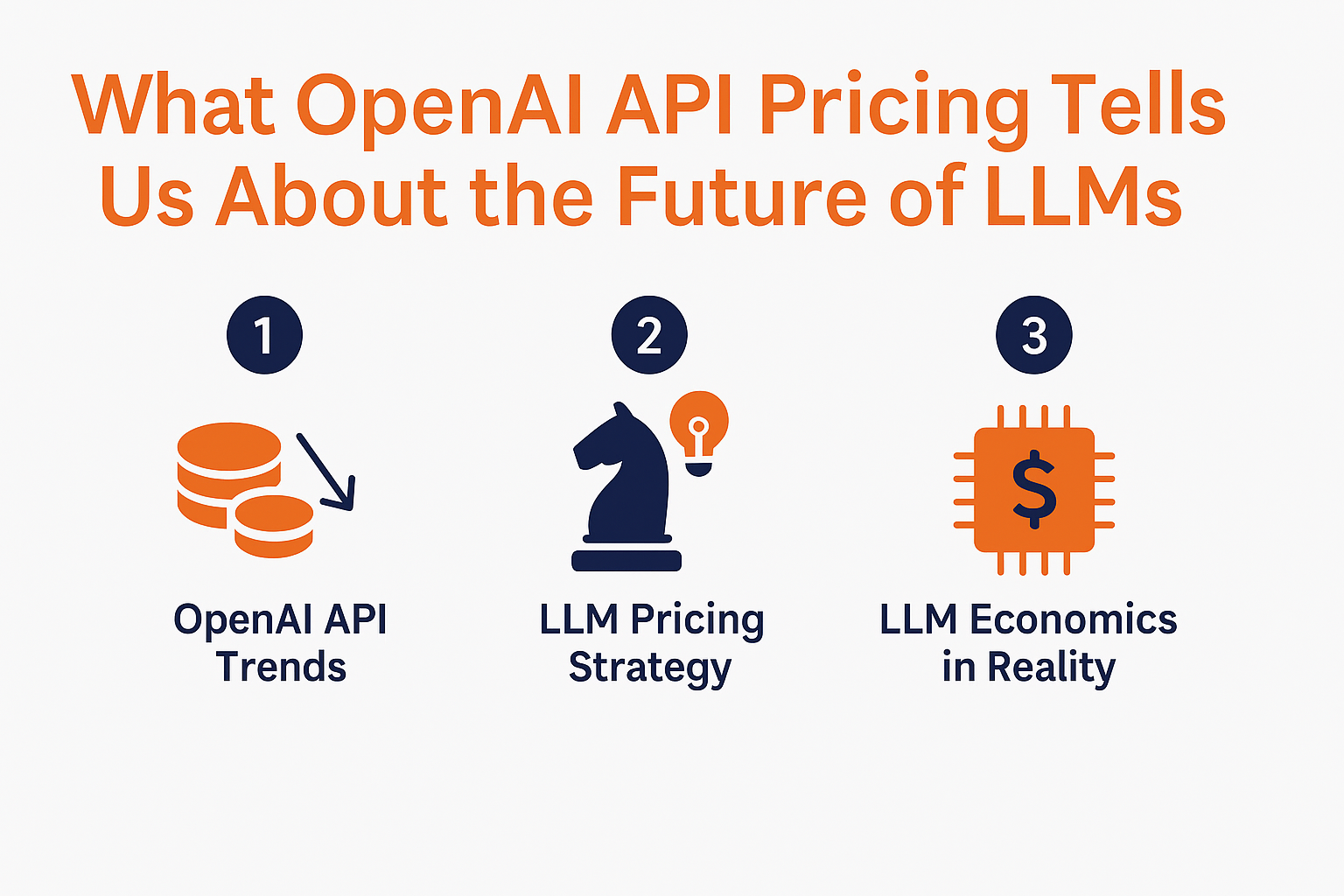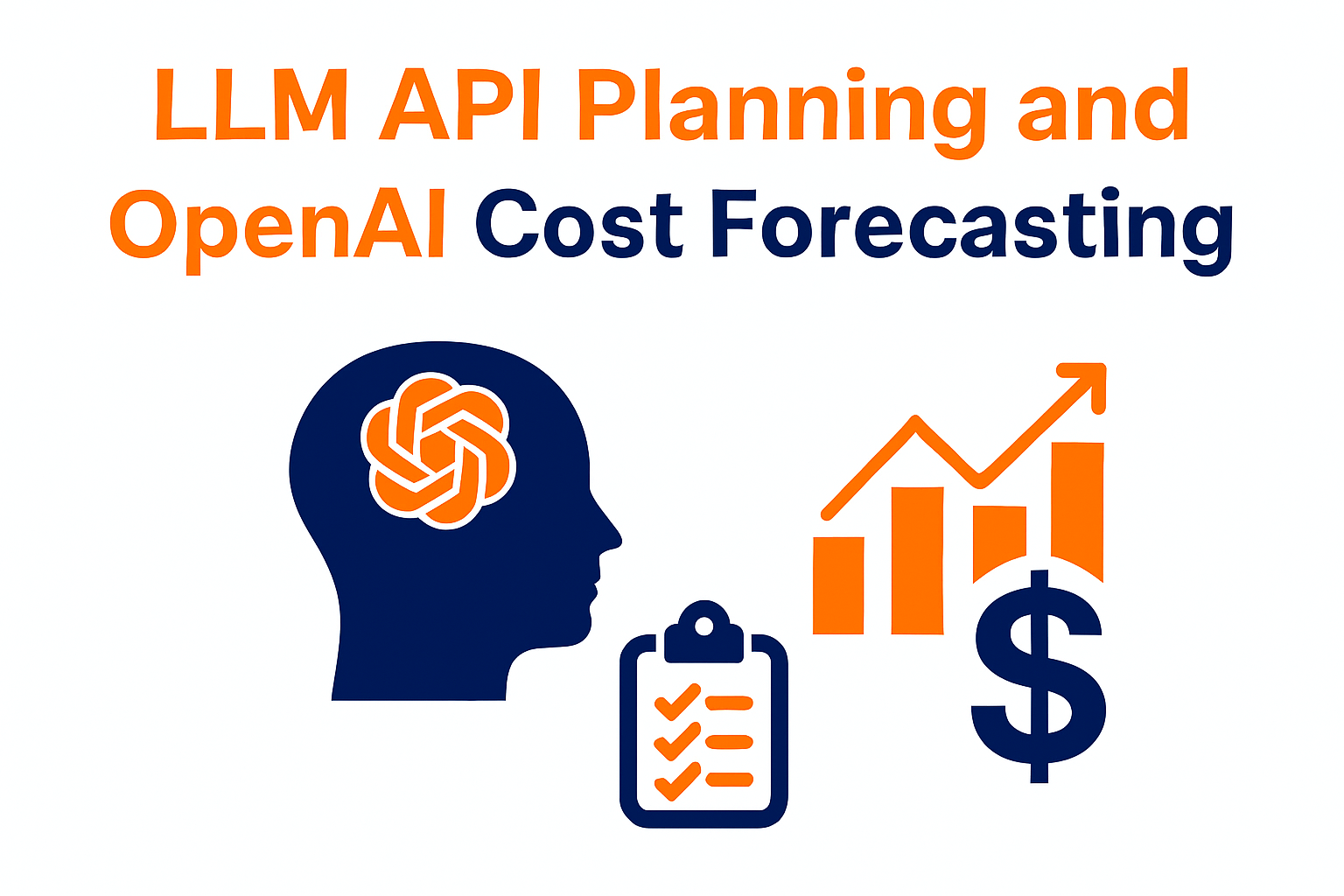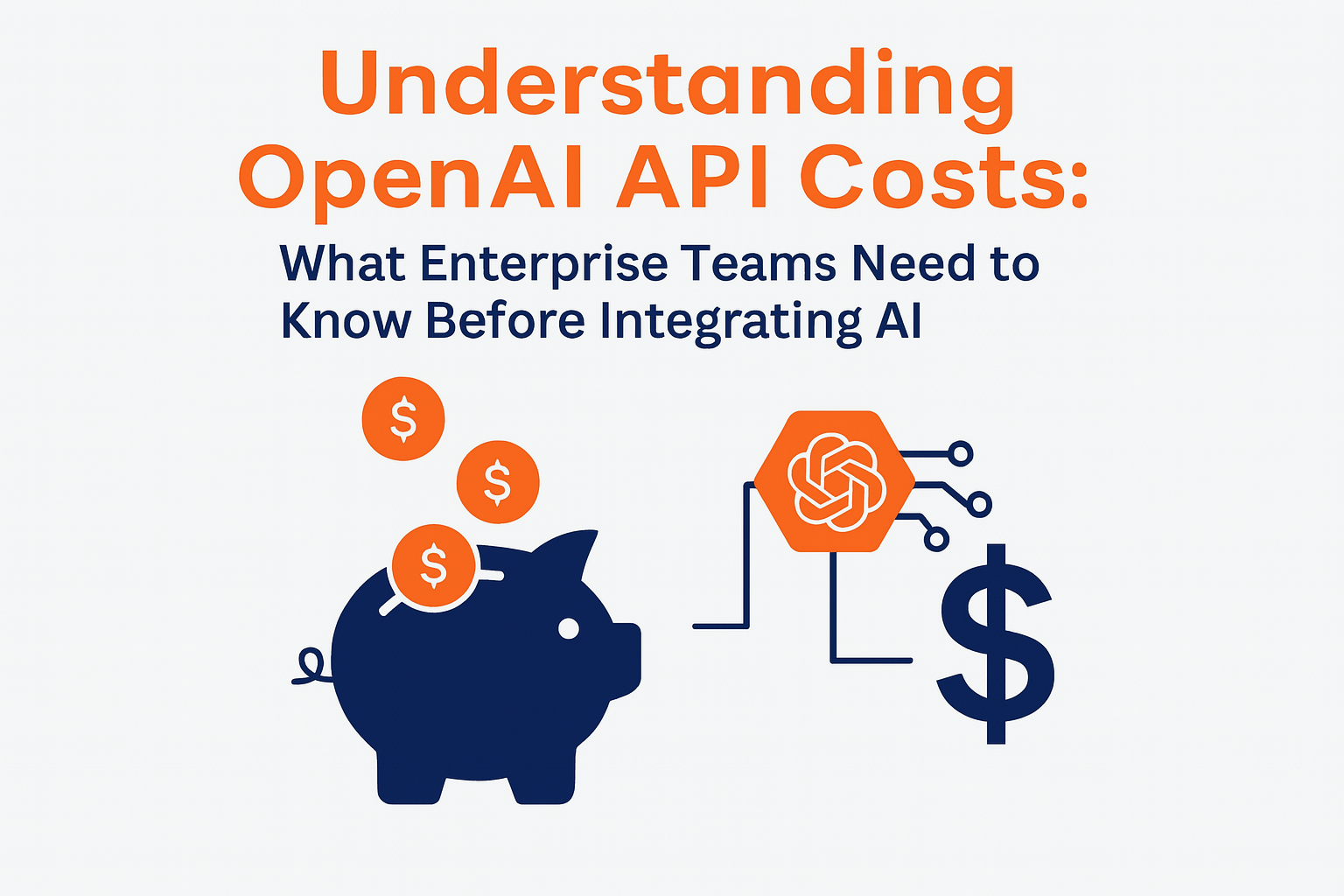July 25, 2025
AI-Driven Observability: The Future of Datadog

Datadog is transforming how businesses monitor their systems with AI-powered tools. These tools predict issues, detect anomalies, and simplify root cause analysis, helping companies prevent downtime and improve system performance.
Key Features of Datadog’s AI Tools:
- Watchdog: Detects unusual error rates and latency issues automatically.
- Forecasting: Predicts resource shortages to prevent failures.
- Correlations: Links metrics for faster problem-solving.
- LLM Observability: Monitors generative AI applications for security and reliability.
Benefits for Businesses:
- Proactive Monitoring: Identify and resolve issues before they escalate.
- Cost Savings: Optimize resource usage and reduce operational costs.
- Industry Applications: Banking, healthcare, and retail use Datadog for security, compliance, and performance monitoring.
Datadog’s AI-driven observability tools are essential for navigating complex infrastructures, ensuring smooth operations, and staying ahead in today’s digital landscape.
Related video from YouTube
Datadog’s AI Features
Datadog’s AI tools take enterprise monitoring to the next level, providing practical ways to improve system performance and address issues before they escalate.
Watchdog Anomaly Detection: Rapid Issue Identification and Response
Watchdog processes billions of events to determine what “normal” behavior looks like [4]. It uses two weeks of historical data to set a baseline and becomes even more effective after six weeks [3].
Here’s what it monitors:
| Monitoring Area | What It Tracks | Detection Capabilities |
|---|---|---|
| System Health | CPU, memory, disk usage | Predicts resource exhaustion |
| Application Performance | Response times, error rates | Detects API throughput anomalies |
| Infrastructure | Cloud resources, database metrics | Identifies resource allocation issues |
| Service Quality | Latency, transaction success | Recognizes performance degradation patterns |
“Watchdog helps our teams focus on the signals that matter by surfacing events that typically aren’t caught by traditional monitors. Looking at Watchdog every morning helps me gain a better understanding of everything happening across our entire technology stack. With the help of Root Cause Analysis, we have all the vital information we need so that our teams are able to investigate and address business-critical issues quickly and efficiently.” – Brent Montague, Site Reliability Architect at Cvent [4]
Beyond anomaly detection, Datadog also uses forecasting tools to predict and prevent potential problems.
Performance Forecasting: Staying Ahead of System Trends
Datadog employs linear algorithms for steady trends and seasonal algorithms for cyclical patterns to predict system behaviors [5]. For instance:
- A fintech company avoided database failure by identifying resource contention early.
- A streaming service saved costs by optimizing cloud resource allocation [6].
Smart Log Analysis: Simplifying Problem Identification
Smart Log Analysis groups similar log entries to uncover unusual patterns without requiring complex queries [7]. It standardizes fields like IP addresses (“192.168.0.XXX”) into searchable formats [7]. The algorithm:
- Groups related logs to pinpoint anomalies
- Highlights frequent clusters
- Filters out low-priority entries
Performance Prediction: Keeping Services Running Smoothly
Datadog’s prediction tools offer insights up to a week in advance, helping teams act before issues arise [5]. For example, during a Black Friday sale, an e-commerce company identified a potential payment gateway bottleneck and avoided an estimated $2 million in lost revenue [2].
Industry Use Cases
Datadog’s AI-powered observability tools are reshaping operations in various industries. Here’s how different sectors benefit from these capabilities.
Banking Security Monitoring
Banks rely on Datadog’s Sensitive Data Scanner to protect critical information. Here’s how it works:
| Security Aspect | Implementation | Business Impact |
|---|---|---|
| Data Classification | Automated scanning of logs, traces, and events | Detects and organizes sensitive data like credit card and banking information. |
| Compliance Monitoring | Pre-configured rules for regulatory standards (e.g., PCI-DSS) | Reduces compliance risks and violations. |
For example, a trading firm implemented custom scanning rules to prevent exposure of sensitive trading positions [8]. Similarly, healthcare and retail industries are leveraging tailored AI monitoring to enhance their operations.
Healthcare Systems Management
Healthcare organizations, including the California Department of Health Care Services and Flatiron Health, are using Datadog to modernize infrastructure, scale efficiently, and minimize system failures while maintaining HIPAA compliance.
“Serving millions of California residents at scale has required us to modernize systems and adopt new cloud technologies. Datadog provides the visibility we need to monitor containerized microservice-based applications across the entire stack with confidence.” [9]
Given HIPAA’s mandate to retain application logs for six years, Datadog’s Sensitive Data Scanner tags sensitive medical data automatically, enabling thorough and compliant monitoring [10].
Retail Operations Monitoring
Retail businesses also benefit significantly from Datadog’s tools. For instance, Neto uses Datadog to boost real-time visibility, support growth, and cut detection times [12].
MercadoLibre, a major e-commerce platform, relies on Datadog for metric correlation. Their Architecture Manager notes:
“We monitor an enormous number of data points, and Datadog has been able to keep up with the collection and correlation of these multidimensional metrics without any issues.” [11]
Datadog’s impact in retail is evident through these examples:
- Orderbird oversees more than 16,000 POS devices with comprehensive observability.
- PlayStation Network optimizes services for over 90 million monthly active users.
- TravelSupermarket achieved a 50% reduction in cloud resource costs [11].
Unlock Potential of Datadog with AVM Consulting
Maximize your investment in Datadog. Our team of certified experts is ready to optimize your observability strategy, enhance system reliability, and simplify your enterprise monitoring. Let’s discuss how AVM Consulting can empower your team.
Setting Up AI Monitoring
Datadog’s AI tools are designed to improve anomaly detection and forecasting. To make the most of these features, it’s essential to configure your setup correctly. Here’s how to get started with Datadog’s AI monitoring tools.
AI Monitoring Setup Guide
Start by deploying Datadog Agent v7.47+ to collect metrics and logs from your AI infrastructure.
| Setup Phase | Key Actions | Expected Outcome |
|---|---|---|
| Initial Deployment | Install Datadog Agent v7.47+ | Enables NVIDIA GPU metrics collection |
| Integration Setup | Configure AI tool connections | Connects to Vertex AI, SageMaker, Ray clusters |
| Dashboard Creation | Deploy pre-built templates | Provides immediate visibility into AI systems |
To gather metrics, configure the Agent with integrations like NVIDIA’s DCGM Exporter for GPU metrics or TorchServe for PyTorch model health checks.
System Integration Steps
- Configure Core Integrations
Renameconf.yaml.exampletoconf.yamlin theconf.dfolder, then update the environment parameters to match your setup. - Activate AI Monitoring
Set up monitoring for key AI components, including:- Vector databases like Weaviate and Pinecone
- Training platforms like Vertex AI and SageMaker
- Distributed computing frameworks like Ray
- Define Custom Metrics
Use thedatadog.yamlfile to add custom metrics that track AI-specific performance. Add appropriate tags to help filter and group data for better insights.
Common Setup Problems and Solutions
| Challenge | Solution | Prevention Tips |
|---|---|---|
| Agent Communication | Check API keys and site settings in datadog.yaml | Verify credentials during setup |
| Resource Metrics | Enable debug mode for detailed logging | Regularly validate metric collection |
| Integration Errors | Use the Agent’s status command to diagnose issues | Keep the Agent updated to the latest version |
For more complex setups, split configurations into multiple YAML files within the <INTEGRATION_NAME>.d folder. This method keeps configurations organized and simplifies troubleshooting. Following these steps ensures a strong foundation for monitoring your AI infrastructure effectively.
What’s Next in AI Monitoring
Emerging AI Monitoring Tools
Datadog is at the forefront of AI observability with its Bits AI feature, which allows users to query data using natural language [14].
AIOps integration is reshaping incident management by:
- Automatically identifying root causes
- Filtering out duplicate alerts
- Spotting anomalies early
- Offering detailed failure analysis [13]
Research highlights that AI-driven observability can reduce costs by 60–80%, as nearly 70% of collected data is unnecessary [15]. These advancements are setting the stage for even more powerful tools.
Datadog’s Upcoming Enhancements
Datadog is working to expand its AI capabilities, aiming to deliver increasingly advanced monitoring solutions. Here’s what’s on the horizon:
| Feature Category | Current Development | Expected Impact |
|---|---|---|
| Predictive Analytics | Machine learning–based forecasting | Helps detect potential system failures early |
| Automation | AI-powered workflow optimization | Lowers MTTR and boosts operational efficiency |
| Integration | Better cross-platform compatibility | Ensures smooth data flow across systems |
“Automating observability streamlines root cause analysis by guiding debugging, reducing errors, and accelerating issue resolution.” – Sam Suthar, Founding Director, Middleware [15]
Getting Ready for New AI Features
As these updates roll out, organizations should prepare their systems to fully benefit from the new AI capabilities. Gartner estimates that by 2026, 70% of organizations effectively using observability will experience faster decision-making [16].
- Adopt OpenTelemetry Standards
OpenTelemetry ensures compatibility with future AI features across multi-cloud setups [15]. - Implement MLOps Practices
Machine Learning Operations (MLOps) helps streamline AI model deployment. Building infrastructure for continuous learning and model refinement is critical [16]. - Integrate Security with Observability
Combining performance monitoring and security threat detection on a single platform is becoming essential. Systems should be ready for this dual functionality [15].
Summary
Datadog is reshaping how enterprises manage their infrastructure with AI-driven observability. With downtime costing Global 2000 companies around $400 billion annually [20], the demand for advanced monitoring tools has never been higher. Datadog’s AI features offer three key benefits:
Improved Operational Efficiency
Datadog’s platform consolidates metrics, logs, and traces for complete visibility [1]. Its Watchdog tool processes billions of data points, automatically identifying anomalies and pinpointing root causes. This allows teams to prioritize critical issues and respond more quickly [19].
Anticipating Issues Before They Happen
Using AI and machine learning, Datadog predicts anomalies, identifies patterns, and simplifies decision-making [1]. This forward-looking approach is crucial as more than 80% of enterprises are expected to adopt generative AI models by 2026 [20].
Cost Management and Security Enhancements
Datadog helps organizations:
- Track resource usage and adjust allocations accordingly [18]
- Enhance security by continuously monitoring model behavior [18]
- Save money by automating routine tasks [17]
Datadog’s leadership is further validated by Gartner’s recognition in the 2024 Magic Quadrant for Observability Platforms [17]. As 90% of enterprises are projected to adopt hybrid cloud infrastructures by 2027 [20], Datadog’s all-in-one observability tools are becoming even more critical for maintaining operational excellence.
These advancements highlight how Datadog not only reduces risks but also drives meaningful improvements in enterprise operations.

More News







